In these days when dinosaur toys only get more and more hyperrealistic, it’s easy to forget that there was a time when they could be inaccurate not just by following outdated science, but also due to complete disregard for any kind of scientific considerations. One of the prime examples of this is the Imperial line of dinosaur figures from the 80s (the ones I have specifically say 1986 on their bellies), which include some of the ugliest dinosaur toys ever created. They had similarities with the Dor Mei figures, and I’m honestly not sure where one line ends and the other begins. These were widely distributed, and kids back then almost couldn’t avoid having a bunch of them in their toy-boxes.
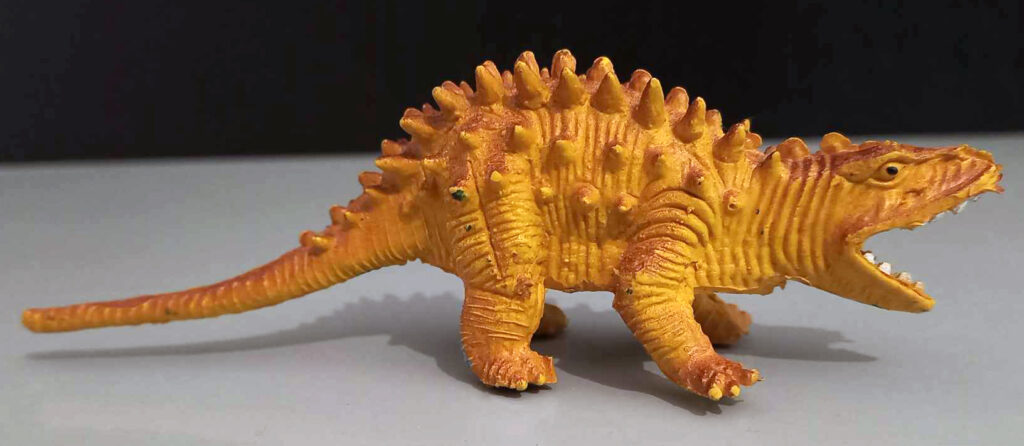
Interestingly (and frustratingly), the line also includes some very obscure taxa, some which have rarely if ever been released in toy form by other companies, but often in very inadequate guises. For example, the Imperial line included a Podokesaurus, a theropod known only from a specimen that was destroyed in a fire, and that’s the only toy representative I know of that genus. While that figure is passable as a small theropod, and other of the Imperial figures are recognisable as what they’re supposed to be, the ankylosaurs of the line are absolutely hideous, which is a shame, because they also represent rarely depicted genera.

These are the ankylosaurid Scolosaurus and the nodosaurid Palaeoscincus, the subject of this review. And off the bat, I can’t help but wonder “what were they thinking?!” These tiny-toothed herbivores are depicted with wide gaping jaws and huge, sharp teeth, that would give any large theropod a run for its money. But okay, at least that’s a consistent feature of the toys, and the carnivorous animals must have even bigger teeth? Nope. The Podokesaurus, Plesiosaurus, and Nothosaurus, which would actually have had sharp teeth, the latter two undoubtedly even sticking out of their mouths at odd angles, have closed jaws and no traces of teeth! And the Stegosaurus? The largest teeth of the lot!
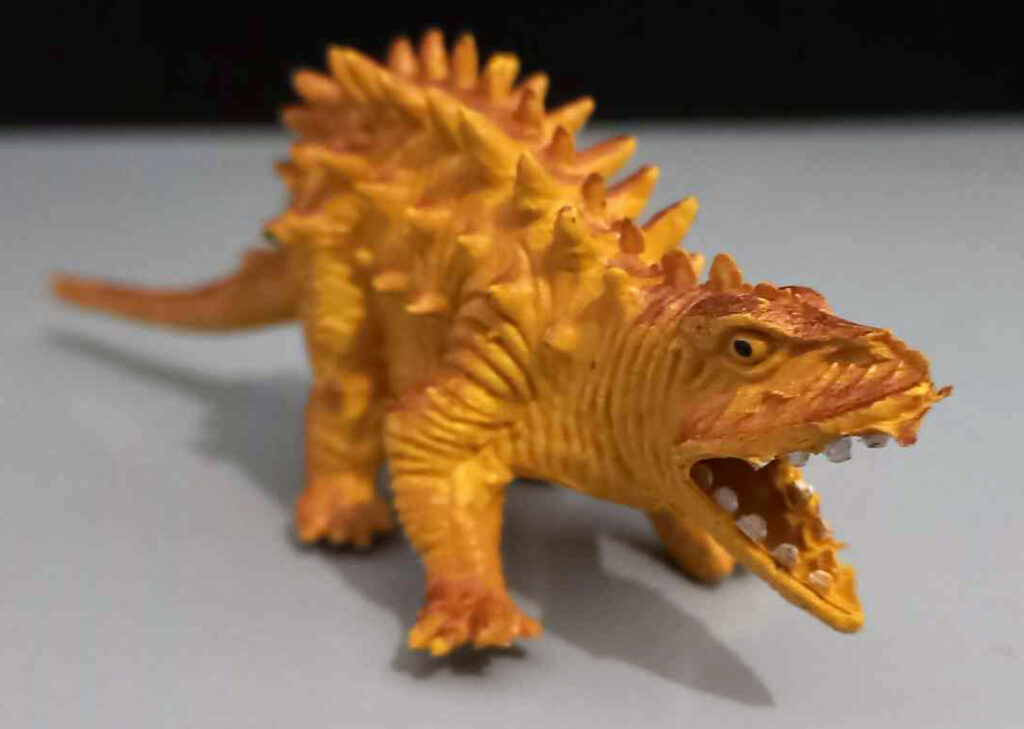
As you may have sensed, I’m shaking with rage as I write this. But it has to be said that the bodies of some of the figures are surprisingly good, and if the Nothosaurus had teeth, it would actually be one of the better toys of it out there. Anyway, back to this particular figure, the Palaeoscincus. This genus is pretty obscure, a historical wastebasket taxon originally based on teeth (why this toy really shows them off?), with various nodosaurid specimens and species assigned to it. This includes what was later split off as Edmontonia, which is what most historical depictions of Palaeoscincus are based on, including the charming Panini figure (which has a tail-club, as a historical curiosity).
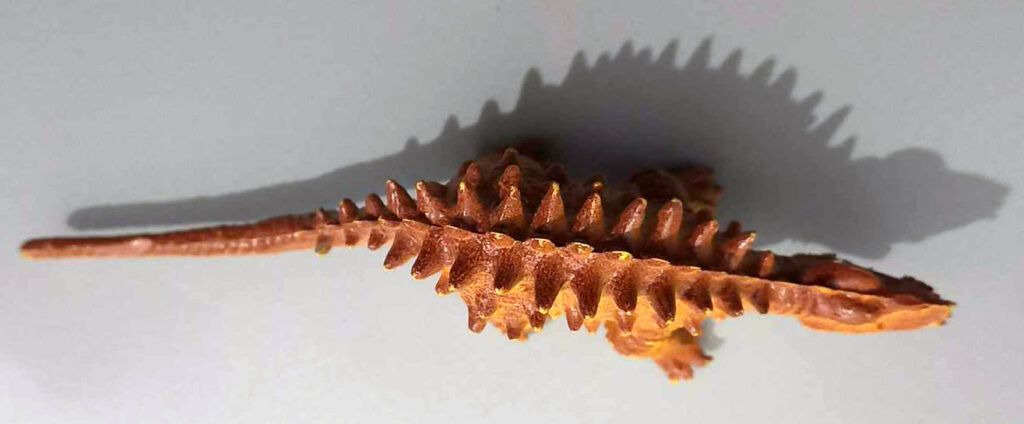
In that regard, this figure is more accurate in lacking a tail-club, but that’s also the best that can be said about it when it comes to accuracy, as nothing else really makes it recognisable as a nodosaur. It has rows of spikes along the upper part of the body, but not really similar to a pattern seen in any nodosaur, let alone Edmontonia, which had spikes along the flanks, but keeled osteoderms on the back. The spikes also stop at the base of the tail, whereas the osteoderms should have continued all the way to the tip. The body-shape is oddly compressed from side to side, whereas ankylosaurs were wide and more compressed from top to bottom. The front legs are somewhat sprawled, but the hind legs quite erect.
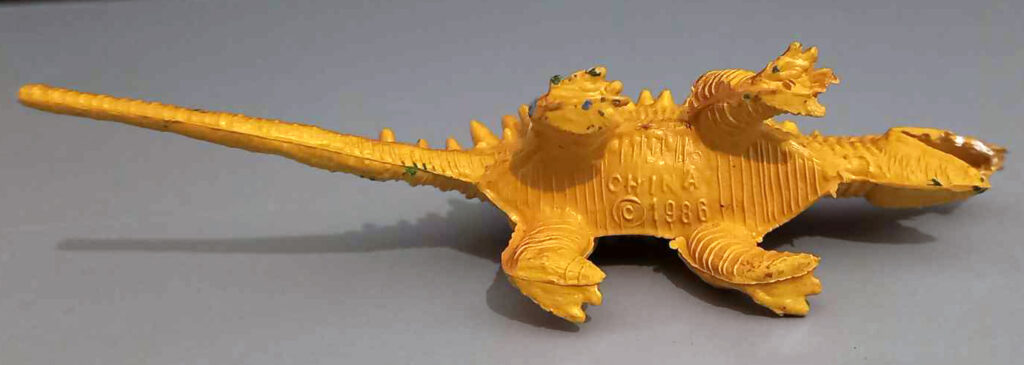
Combined with the very non-ankylosaurian head with its lack of armour, huge teeth and open mouth (stuff could actually get lost in there, the hole continues all the way to the tail), the figure looks like some sort of amorphous reptile-monster at worst, and maybe somewhat like a spiky “mammal-like reptile” at best. Maybe even a monstrous skink, per its namesake? But a dinosaur? Not really… In its defence, the wrinkly texture across the body is kind of lifelike, and the spikes are pretty well-done. The plastic is a bright orange, with darker, brownish orange paint at the upper part, which actually looks pretty nice. The teeth are white and the pupils black, luxuries which many other low-end figures did not have.

Despite those qualities, this is no doubt my nominee for ugliest dinosaur figure ever created, and I’m surprised someone actually made knock-offs of them, and, believe it or not, they were even uglier! I have one in cream-coloured plastic with red eyes (otherwise unpainted) that doesn’t seem to be a direct copy, but actually sculpted after the same figure (various details differ, notably the wrinkles and proportions). Or is the orange one the actual knock-off? Looking around, it seems that the spiky tail on the creamy one makes it more similar to photos I can find of figures identified as the Imperial version, but I wonder if anyone really has an overview of these mysterious figures. Could they be variants from the same company?

Both figures are around 13 cm long and 4 cm tall, but the cream one is much more robustly built, with a sleeker, almost shark-like feel to its head. The upper margin of its head is slightly concave, whereas that of the orange one is more convex, and has a very flaky spike at the back. I guess this is not a figure anyone really asked for to be reviewed, but for the sake of completeness, someone has to do it! So sorry for the rambling rant, but I think that’s probably an adequate style for figures like these, that are almost just excuses for passing off generic monsters as dinosaurs. I can basically only recommend it for being one of the only figures out there depicting Palaeoscincus.
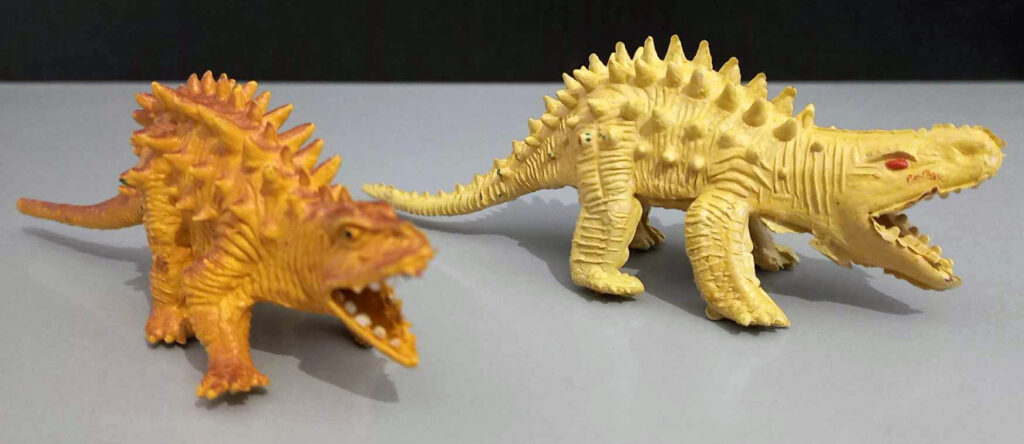
Disclaimer: links to Ebay and Amazon on the DinoToyBlog are affiliate links, so we make a small commission if you use them. Thanks for supporting us!




Although awful, I kinda like these screaming dinosaur toys. Reminds me of childhood (even though i was already collecting dinosaur figures from the main brands at 3 and I didn’t own any chinasaur lol). 2 stars
I feel like this thing, or some knock off variant of it, just materialized in the toy box of every child for a fair while there back in the 80s and 90s. For that nostalgia alone it has a place in my heart.
What’s your source for this toy representing Palaeoscincus? I own one with belly text that reads:
MADE IN CHINA
© 1986 CE
SCELIDOSAURUS
Mine is clearly another version of the same thing as yours, with various subtle differences: chestnut brown plastic under greenish yellow paint, midline osteoderms continue the full length of the tail, torso a bit more plump, stubbier digits, higher-quality moulding without the ragged appearance at the seams. Head shape more similar to your orange one. I suppose I can send pics if requested.
Amusingly, the recently discovered dinosaur Spicomellus afer might have looked vaguely like this, for all we know of it!
Interesting, mine has no name on the belly, but I was going by the back of the packaging seen here: https://i.ebayimg.com/images/g/r-gAAOSwc65mnS9t/s-l1600.webp
See also these cards: https://dinofan.com/Collectibles/CollectiblesSetDetail.aspx?IID=813
So it would seem they retooled the same figure for two genera, but I agree it would pass better as Scelidosaurus…
Of the “screamers” from my childhood this was always a favorite of mine. Possibly because it didn’t look like any actual dinosaur, it was just doing its own thing and that gave it character. I have at least one in my older daughter’s box of dinosaur but it’s up in the attic. It’s purple.
I’ve got a few of these, or knockoffs at least, in storage from childhood. As a kid I don’t think I even bothered trying to identify them because they were obviously not trying to be anything more than little monster toys – which they functioned as very nicely!